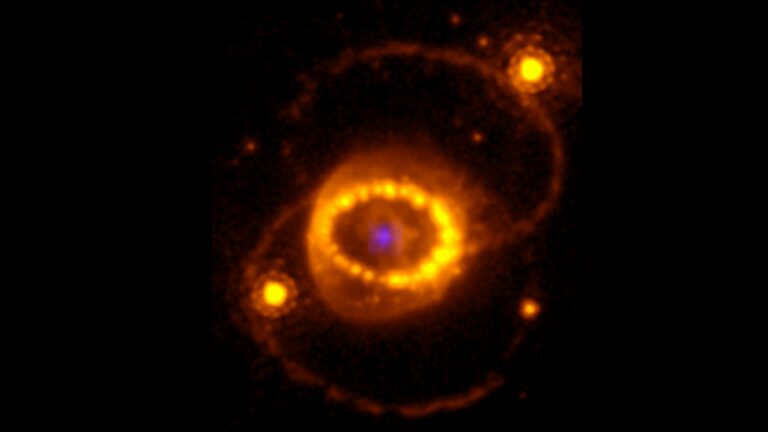The neutron star left behind by supernova 1987A has been detected by the JWST, revealing intriguing clues.
The neutron star resulting from the explosion of supernova 1987A has been identified through observations made by the JWST, uncovering fascinating hints.
Astronomers have discovered compelling evidence for a neutron star within the remnants of supernova 1987A, the most famous stellar explosion in modern history. The James Webb Space Telescope, operated by NASA, has detected indirect hints of a powerful source of X-rays emanating from the core of the supernova remnant. This discovery, reported on February 22 in the journal Science, marks a significant milestone in a 37-year-long quest to understand the aftermath of the closest supernova in nearly four centuries. Furthermore, it offers valuable insights into the behavior of neutron stars in the decades following their formation. Astronomer Patrick Kavanagh, speaking at a news conference on February 17, described Supernova 1987A as a unique laboratory for studying supernovas. He emphasized that this ongoing research continues to yield new discoveries, making it a gift that keeps on giving. Kavanagh is affiliated with Maynooth University in Ireland.

On February 23, 1987, telescopes worldwide witnessed a remarkable supernova in the Large Magellanic Cloud, a satellite galaxy of the Milky Way. This event, known as supernova 1987A, was caused by the death of a star at least eight times the mass of the sun. Despite being located 160,000 light-years away, the explosion was visible to the naked eye for several months. The release of a significant number of neutrinos during the explosion, some of which were detected on Earth, marked a groundbreaking discovery of these elusive particles originating from outside our solar system.
In the aftermath of supernova 1987A, scientists have speculated whether the core of the blue supergiant star collapsed into a neutron star or transformed into a black hole. The detection of neutrinos escaping the event suggests the former scenario, yet the actual remnant remains elusive. The surrounding dust, created by the star’s outer layers moving at 10,000 kilometers per second, has hindered observations and prevented a conclusive identification of what lies at the heart of this cosmic event.
Infrared light passes through dust more easily than other wavelengths. Therefore, the infrared sensors of the James Webb Space Telescope (JWST) are ideal for observing the cloud surrounding 1987A. Using the JWST, Kavanagh and his team detected light that contained signatures indicating the presence of argon and sulfur in the dusty central area. Notably, these elements were ionized, indicating that some of their electrons had been removed.
According to coauthor Claes Fransson, an astronomer at Stockholm University, “A source of high-energy [X-rays] is required to create these ions. The question is: ‘What is causing this ionization?'”
The team proposes two possibilities. Supernova 1987A may have left behind a pulsar, a highly magnetized neutron star that emits powerful radiation beams, similar to the one found in the nearby Crab Nebula, the remnant of a supernova nearly 1,000 years old. Alternatively, the X-rays could be emitted by a regular neutron star, whose newly formed surface would shine at a temperature of a million degrees Celsius.
“This is some of the most compelling indirect evidence for the presence of a neutron star,” says Aravind Pazhayath Ravi, an astrophysicist at the University of California, Davis, who was not part of the study. Although it is not a direct observation yet, it complements previous data collected by instruments like the Atacama Large Millimeter/submillimeter Array.
If scientists can directly capture light from the neutron star, they will be able to compare it with older neutron stars elsewhere in the universe, providing astronomers with insights into the internal structure of these exotic objects. However, the clouds surrounding the remnant of 1987A will likely need to dissipate further, a process expected to occur in the next decade or so, according to Ravi.
“It is inevitable that we will eventually have an image of the youngest observed neutron star,” he concludes.
Do not forget to share your opinion with us to provide you with the best posts !




0 Comments